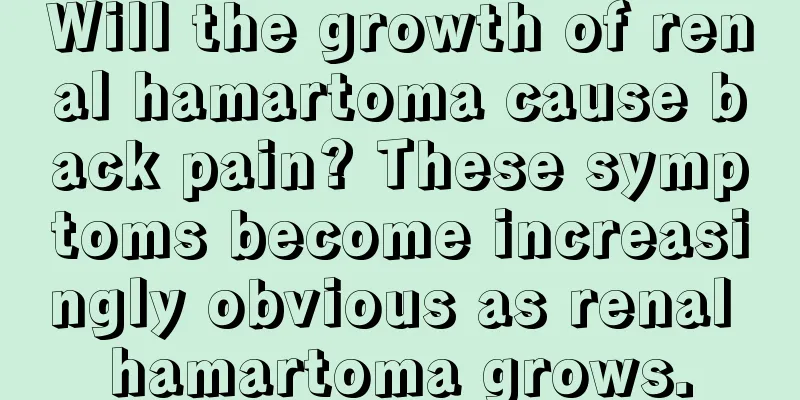Will the growth of renal hamartoma cause back pain? These symptoms become increasingly obvious as renal hamartoma grows.

|
Renal hamartoma is composed of abnormally proliferating fat, blood vessels and smooth muscle in a certain proportion, so it is also called renal angiomyolipoma. Most renal hamartomas have no obvious symptoms in the early stage, and only mild pain. When the size of the renal hamartoma increases and compresses the surrounding organs and tissues, low back pain, hematuria, abdominal mass and some digestive symptoms will occur. Renal hamartoma is a benign tumor. It was rare in the past, but in recent years, with the development of medical detection technology and the enhancement of health awareness, the detection rate of renal hamartoma has been increasing year by year. Renal hamartoma will only show symptoms and be discovered when the tumor grows to a certain size, compresses surrounding organs or ruptures and bleeds. So, what symptoms will gradually become obvious when the renal hamartoma grows? Will the renal hamartoma cause back pain when it grows? 1. As the size of the renal hamartoma continues to increase, the pain will first intensify. In the early stage, it is only a slight pain. As the tumor size increases, the tension of the renal capsule increases, and the renal pedicle is pulled. The enlarged tumor will cause a sudden increase in the pressure on the kidney, and the downward pulling will cause pain. The pain is dull and radiates to the waist and back. 2. When the size of the renal hamartoma increases and compresses the duodenum, stomach and other organs, some digestive tract discomfort symptoms will appear, such as upper abdominal pain, nausea, loss of appetite, etc. 3. When a renal hamartoma grows and suddenly ruptures, it will manifest symptoms such as waist and abdominal pain and hematuria. Hematuria can be manifested as microscopic hematuria, i.e. occult blood; or hematuria visible to the naked eye, and the onset is cyclical. Macroscopic hematuria often occurs after sudden exertion such as urination, defecation, coughing, etc., which will cause a sudden increase in abdominal pressure, leading to rupture and bleeding of the renal hamartoma, resulting in hematuria. 4. It may also manifest as a mass in the abdomen, which is also the main reason for some patients to undergo examinations. In case of severe hemorrhage or excessive tumor size, a mass may be felt in the abdomen, which may lead to shock in severe cases. When the above symptoms occur, it means that the tumor has grown in size and is compressing the surrounding organs. At this time, you need to see a doctor as soon as possible. Once a renal hamartoma is diagnosed, it is necessary to choose an appropriate treatment plan as soon as possible based on the location, size and development of the tumor, because renal hamartomas develop rapidly and once the tumor ruptures and bleeds, it will be life-threatening. |
<<: How to prevent bladder cancer recurrence: 6 tips to keep in mind
>>: Overview of knowledge related to renal hamartoma
Recommend
Is peach a cold fruit?
Peaches are a kind of fruit we often eat. The nut...
What is cervical cancer
Nowadays, many female friends are very tired. Com...
Ratchet effect
Many people often hear about some personal habits...
Solar plexus
Everyone will get sick to some extent, and when y...
Is okra effective in lowering blood pressure? Nutritional value of okra
Patients with hypertension are very painful after...
What causes blepharitis
Blepharitis is actually what people often call st...
Is it necessary to have morning urine for routine urine test
When doing a routine urine test, morning urine is...
Endometrial cancer screening ultrasound
Endometrial cancer may be unfamiliar to many wome...
How to install dentures
Although dental problems are not serious diseases...
What should I do if I am allergic to paint?
I believe that there are many friends who suffer ...
Does brain CT scan cause great harm to the human body?
Brain CT is the main test to check whether there ...
I don't know what kind of insect bit me and it's itchy, swollen and painful
Summer is here, and as the temperature rises, a l...
Sodium hypochlorite disinfectant
Sodium hypochlorite disinfectant is actually a co...
Three kinds of medicinal diet treatments for esophageal cancer of weak Yang Qi
Esophageal cancer is classified as "dysphagi...
What are the methods to treat premature ejaculation in men?
For male friends, there are also many issues that...









